Uncategorized
New translation: The life and death of a shtetl during the Russian Civil Wars
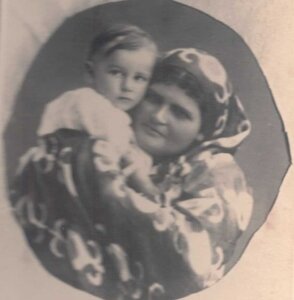
אין 1926 האָט רחל פֿײַגנבערג פּובליקירט „חורבן דובאָװע׃ אַ פּינקס פֿון אַ טױטער שטאָט“ כּדי צו פֿאַראײביקן דעם אָנדענק פֿון דער ייִדישער קהילה פֿון דובאָװע, אַ שטעטל אין הײַנטיקער אוקראַיִנע. די דאָזיקע קהילה איז פֿאַרטיליקט געװאָרן אין 1919 בעת דער רוסישער בירגערקריג — אַ קאָנפֿליקט װאָס האָט דערפֿירט צו גרױליקע פּאָגראָמען קעגן ייִדן.
איצט איז פֿײַגנבערגס בוך אַרױס אױף ענגליש ווי אַ טייל פֿון דער סעריע ייִדישע שטימען (Yiddish Voices), אַ שותּפֿותדיקער איניציאַטיוו צװישן YIVO און בלומסבערי װאָס זעצט איבער טעקסטן װעגן ייִדיש לעבן אין מיזרח־אײראָפּע. (איך אַלײן בין אַן אַסיסטענטקע פֿון ייִדישע שטימען.)
פֿײַגנבערגס בוך הײבט זיך אָן מיט אַ פּאָרטרעט פֿון ייִדיש לעבן אין דובאָװע פֿאַר די קאַטאַסטראָפֿעס פֿון 1919. די שילדערונג איז װיכטיק װײַל דובאָװע איז דװקא נישט געװען ספּעציעל װיכטיק. ס׳איז געװען סתּם אַ שטעטל, װוּ אַן ערך טױזנט פּשוטע ייִדן האָבן פֿאַרדינט ברױט, אױפֿגעצױגן קינדער, געפּראַװעט שבת און זיך געקריגט װעגן קלײניקײטן. יאָרן לאַנג האָבן זײ געװױנט מער־װײניקער בשלום צװישן דובאָװעס נישט־ייִדישע פּױערים. װען פֿײַגנבערג באַשרײַבט די פּאָגראָמען פֿילט מען דעם שאָק װאָס די דובאָװער ייִדן האָבן מסתּמא געפֿילט װען אַזאַ טאָג־טעגלעך אָרט איז פֿאַרריסן געװאָרן פֿון גװאַלד.
איך האָב געשמועסט מיט דער היסטאָריקערין עליסאַ בן-פּורת, װאָס האָט רעדאַקטירט די ענגלישע איבערזעצונג פֿון פֿײַגנבערגס בוך, און האָט אױך אָנגעשריבן די היסטאָרישע הקדמה. זי האָט מיר געהאָלפֿן פֿאַרשטײן װי און פֿאַר װאָס פֿײַגנבערג האָט מחבר געװען די מעשׂה פֿון דובאָװע, װוּ זי אַלײן האָט קײן מאָל נישט געװױנט.
פֿײַגנבערג איז שױן געװען אַ געראָטענע ייִדישע שרײַבערין פֿאַר דער ערשטער װעלט־מלחמה. „זי איז טאַקע געװען די ערשטע פֿרױ װאָס האָט געאַרבעט װי אַ פּראָפֿעסיאָנעלע מחברטע אױף ייִדיש — װאָס האָט געהאַט פּרנסה פֿון ייִדישער בעלעטריסטיק און זשורנאַליסטיק,“ האָט בן-פורת געזאָגט. נאָך פֿײַגנבערגס חתונה אין 1914 און דעם געבױרן פֿון איר זון האָט זי אָבער אויפֿגעהערט צו שרײַבן. לױט בן-פורת האָט פֿײַגנבערג „אַנטדעקט אַ נײַ שליחות װי אַ מחברטע“ נאָך די פּאָגראָמען, אַ שליחות װאָס האָט באַנײַט איר שרײַבערישע קאַריערע.
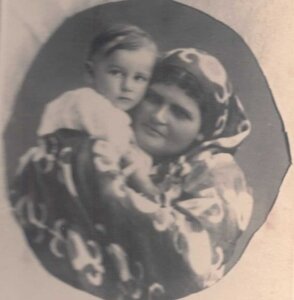
אין 1919 האָט פֿײַגנבערג געװױנט אין יאַנאָװקע אין אוקראַיִנע, נאָענט צו אומאַן און דובאָװע. יענעם זומער האָבן פּאָגראָמיסטן חרובֿ געמאַכט דאָס הױז װוּ זי האָט געװױנט מיט איר יונגן זון (איר מאַן איז שױן געשטאָרבן). זי האָט שפּעטער באַשריבן װי זי מיט איר קינד זענען אַנטלאָפֿן פֿון יאַנאָװקע איבער װעגן װוּ כוליגאַנען האָבן געזוכט ייִדן צו דערהרגענען. אַ בולגאַרין וואָס האָט רחמנות געהאַט אויף איר האָט איר געגעבן אַ קלײד מיט די בולגאַרישע נאַציאָנאַלע־פֿאַרבן, װאָס האָט געדינט װי אַ פֿאַרשטעלונג. פֿײַגנבערג האָט געהאָנגען אַ צלם אַרום איר זונעלעס האַלדז. על־פּי נס זענען זײ אָנגעקומען אין אָדעס.
דאָרטן האָט פֿײַגנבערג אָנגעהױבן אינטערװיויִרן לעבן געבליבענע פֿון די פּאָגראָמען, װאָס זענען אַנטלאָפֿן קײן אָדעס פֿון פֿאַרשײדענע שטעט און שטעטלעך. איר נאָענטער חבֿר, דער מחבר מרדכי ספּעקטאָר — װאָס איז געװען אַ געבױרענער אין אומאַן, נאָענט צו יאַנאָװקע און דובאָװע — האָט זי דערמוטיקט צו פֿאַרשרײַבן די אינטערװיוען.
דער באַרימטער היסטאָריקער אליהו טשעריקאָװער, װאָס האָט אױסשעפּיק דאָקומענטירט די פּאָגראָמען פֿון דער בירגערקריג, האָט זיך דערוווּסט וועגן איר אַרבעט. ער האָט איר געבעטן זי זאָל צוגרײטן אַ באַריכט ספּעציפֿיש װעגן דובאָװע. „דערמיט איז פֿײַגנבערג געװאָרן די אײנציקע פֿרױ װאָס האָט געהאָלפֿן טשעריקאָװערן מיטן צונױפֿנעמען זײַן ריזיקן פּאָגראָם־אַרכיװ, חוץ זײַן אײגענער פֿרױ“, האָט בן-פּורת געזאָגט.
פֿײַגנבערגס ערשטער דובאָװע־באַריכט פֿון 1921־1922 איז געװען גאַנץ קורץ און תּמציתדיק. במשך פֿון די קומעדיקע יאָרן האָט זי אים איבערגעאַרבעט און אַנטװיקלט אין אַ שפּאַנענדיקער נאַראַציע, װאָס איז אַרױס אין װאַרשע אין 1926. „דער דאָזיקער נוסח באַשרײַבט בריהש די שטעטלדיקע סבֿיבֿה און די פּערזענלעכקײטן פֿון די פֿאַרשײדנאַרטיקע ייִדן. מע זעט זײ דורך אירע אױגן װי אמתע מענטשן, מיט מעלות און חסרונות,“ האָט בן-פּורת געזאָגט.
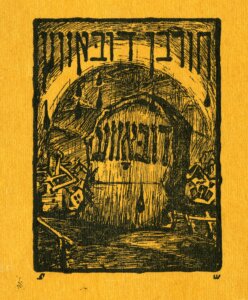
אױף מיר האָט געמאַכט אַ ספּעציעלן רושם דער דובאָװער רבֿ, משה אַהרן בערדיטשעװסקי — אַ למדן װאָס איז שױן געװען אַן אַלטער אין 1919. ער האָט זיך נישט אַרײַנגעמישט אין די אָרטיקע קריגערײַען, און איז געווען שטאַרק באַליבט. איך קען זיך אױך פֿאָרשטעלן דעם אַפּטײקער װאָס האָט זיך געשעמט מיט דער אײגענער ייִדישקײט און האָט נאָר געהאַט קריסטלעכע חבֿרים. און אױך משה שװאַרצמאַן דער סטעלמאַך (ראָד־מאַכער), אַן אָרעמאַן װאָס האָט זיך אַלע מאָל באַטײַטיק אַרױסגעזאָגט װעגן קהלשע ענינים.
די ערשטע כװאַליע פֿון די דובאָװער פּאָגראָמען האָבן דורכגעפֿירט די אָרטיקע פּױערים — מענטשן װאָס די ייִדן האָבן לאַנג געקענט. פֿײַגנבערג דערצײלט װי די אָנפֿאַלערס האָבן אױסגעפֿאַרבט די פּנימער כּדי מען זאָל זײ נישט דערקענען. די ייִדן האָבן זײ אָבער אַלע דערקענט. בעת דער צװײטער כװאַליע האָבן באַנדיט־סאָלדאַטן פֿון די קעמפֿנדיקע אַרמײען געפּײַניקט דעם אַלטן רבֿ במשך פֿון אַ פּאָר טעג אײדער זײ האָבן אים דערהרגעט. זײַן קערפּער האָבן זײ געװאָרפֿן אין אַ קאַלך־גרוב צוזאַמען מיט הונדערטער אַנדערע. קרבנות פֿון דער דריטער כװאַליע, אױך מערסטנס דורכגעפֿירט פֿון באַנדיטן און סאָלדאַטן, זענען אַ מאָל באַגראָבן געװאָרן לעבעדיק. פֿאַרגװאַלדיקונג איז געװען פֿאַרשפּרײט.
נאָך די פּאָגראָמען האָט מען חרובֿ געמאַכט דעם ייִדישן בית־עולם און דאָרטן פֿאַרפֿלאַנצט תּבֿואה. חוץ אַ פּאָר לעבן־געבליבענער װאָס זענען אַנטלאָפֿן האָבן די ייִדן פֿון דובאָװע מער נישט עקסיסטירט.
אין 1927 האָט פֿײַגנבערגס „חורבן דובאָװע“ געשפּילט אַ ראָלע אינעם פּראָצעס פֿון שלום שװאַרצבאָרד, אַ יונגער ייִדישער אַנאַרכיסט װאָס האָט מיט אַ יאָר פֿריִער דערמאָרדט שימאָן פּעטליוראַ אין פּאַריז. פּעטליוראַ איז געװען אַן אוקראַיִנישער פּאָליטיקער און אַמאָליקער מיליטאַר־קאָמאַנדיר װאָס שװאַרצבאָרד — װי אַ סך ייִדן — האָט געהאַלטן פֿאַר שולדיק אין די פּאָגראָמען. אַ פֿראַנצײזישע איבערזעצונג פֿון פֿײַגנבערגס בוך איז געװען אַ טײל פֿון זײַן פֿאַרטײדיקונג, כּדי צו באַשטעטיקן די גרױלן פֿון די פּאָגראָמען. שװאַרצבאָרד איז באַפֿרײַט געװאָרן פֿון שולד.
„אַ דאַנק דער איבערזעצונג אױף ענגליש װעלן נײַע לייענער אַנטדעקן פֿײַגנבערגס װערק“, האָט בן-פּורת געזאָגט. „אַזעלכע טעקסטן קענען באַװירקן אונדזער קוקװינקל סײַ אױף דער געשיכטע, סײַ אױף די הײַנטיקע צײַטן. די מעשׂה פֿון דובאָװע דאַרף זײַן אַ טײל פֿון די דאָזיקע דיסקוסיעס.“
The post New translation: The life and death of a shtetl during the Russian Civil Wars appeared first on The Forward.
Uncategorized
Ritchie Torres Faces New Socialist Opponent in Democratic Primary Race Amid DSA Victory Lap Over Mamdani Win
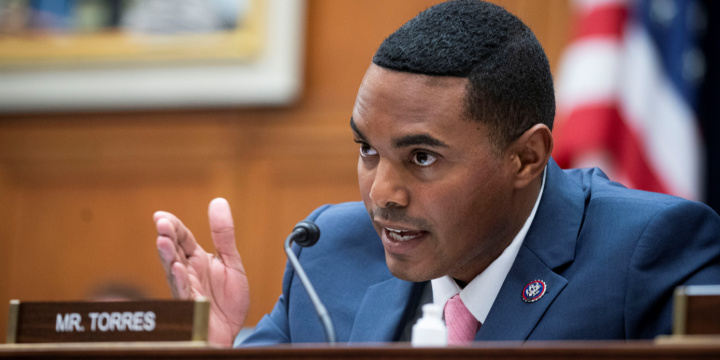
US Rep. Ritchie Torres (D-NY) speaks during the House Financial Services Committee hearing in Washington, DC, Sept. 30, 2021. Photo: Al Drago/Pool via REUTERS
Public defender and Democratic Socialists of America (DSA) organizer Dalourny Nemorin has launched a primary challenge against US Rep. Ritchie Torres in New York’s 15th Congressional District, setting up a competitive intra-party contest in one of the nation’s poorest districts.
Nemorin announced her campaign on Wednesday at the Andrew Freedman Home in the Bronx, where she emphasized housing affordability, public housing conditions, immigrant services, and economic hardship as central issues facing the district. She said many residents feel underserved and argued that the district requires “a new type of leadership.” The area has a median household income of about $44,000, with more than 30 percent of residents living below the poverty line.
Torres, first elected in 2020, is a high-profile Democrat known for his work on housing oversight and for being the first openly LGBTQ Afro-Latino member of Congress. He currently serves on the House Committee on Financial Services and has been a vocal supporter of Israel, a position that has drawn national attention and, in some cases, criticism from the Democratic Party’s left wing.
Nemorin, a member of the far-left DSA, is directly targeting Torres on campaign financing and foreign-policy stances, criticizing his acceptance of contributions from real-estate developers and from the American Israel Public Affairs Committee (AIPAC). She argued these ties reflect a misalignment between the congressman’s priorities and the needs of the district. Torres’s campaign has previously defended its donor base as consistent with his longstanding policy positions and record.
“I think the country is talking about a new type of representation, a new type of Democrat, a new type of leadership, which is what Zohran’s race represents,” she said, referring to Zohran Mamdani, who was elected mayor of New York City last week.
Mamdani, a democratic socialist and anti-Israel activist, is also a member of the DSA, which appears to see his victory as a sign of momentum. The organization has reportedly created a list of far-left demands for Mamdani when he assumes office. Most of the demands concern boycotts targeting Israeli-linked entities.
Nemorin’s challenge highlights ongoing divisions between establishment Democrats and progressive organizers in New York City. Her campaign launch drew a largely young audience, signaling an effort to mobilize voters who have historically had low turnout in the district. Her campaign has said it will focus on door-to-door organizing and outreach in public-housing complexes.
Since entering Congress, Torres has positioned himself as an outspoken ally of Israel. As the Democratic Party has continued to grow increasingly critical of Israel over the past two years, amid the Gaza war, Torres has staunchly defended the Jewish state’s right to defend itself from existential threats such as the Hamas and Hezbollah terrorist groups. He has also spoken against rising antisemitism in New York City, even calling on local universities to adopt more vigorous policies protecting Jewish students. However, his strident support for Israel has sparked ire among the left flank of his own party.
Torres enters his reelection bid with significant advantages, including incumbency, name recognition, fundraising capacity, and a political network built over multiple election cycles. Primary defeats of sitting members of Congress remain rare, but progressive groups have succeeded in previous New York races when able to drive high turnout among younger voters and renters. Torres is expected to receive huge levels of support from the Jewish community within his district.
Moreover, Torres represents the poorest district for young people in the country, which is majority black and Latino, demographics with which far-left candidates have historically struggled. Observers have also pointed out that former New York Gov. Andrew Cuomo won Torres’s district during this year’s Democratic mayoral primary in New York City over the more progressive Mamdani, suggesting that the district possesses a deep reservoir of moderate voters.
The Democratic primary is scheduled for June 2026. Both campaigns are expected to center their messaging on housing, affordability, and constituent services. However, Torres’s opponents, including former New York assemblyman Michael Blake, have taken repeated swipes against his record on Israel, indicating that they will attempt to center the war in Gaza as a main point of attack during the primary. In his launch video, Blake attacked Torres for supposedly supporting a “genocide” in Gaza.
“I am ready to fight for you and lower your cost of living while Ritchie fights for a genocide,” Blake said in an announcement video.
Uncategorized
Her parents fled Mexico and Mandatory Palestine, taking their traumas with them
When Colette Ghunim’s parents first met in 1978, they quickly learned they had something in common: They both were forced to leave their homelands.
In her documentary Traces of Home, Ghunim travels with her immediate family back to her parents’ home cities. Hosni, Ghunim’s father, was expelled with his family from Safed, Mandatory Palestine, in 1948, when he was four years old. Ghunim’s mother Iza left Mexico City as a child to escape her abusive father. The film uses archival footage from Ghunim’s childhood, photos from her parents’ past, and animation to portray the harrowing journeys both her parents took. It’s a moving study of how trauma is inherited, but skirts some of the geopolitical issues at its core.
Ghunim, director of The People’s Girls, a documentary about sexual harassment in Egypt, explains in Traces that she never felt truly connected to either of her ethnic backgrounds, Mexican or Palesitnian. Her parents’ goal, she says, was to “make my life simple, safe, and American.”
It was also supposed to be tidy and unemotional. Archival footage shows Ghunim at five years old reading a letter from “Santa” reminding her of her promise to her mom: “No more crying.” Such a display of unpleasant feeling would disrupt the image of a perfect household.
The film unpacks how these expectations were in part the way Ghunim’s parents responded to their traumatic pasts — but these restrictions had unintentional consequences for their children: Ramsey developed an abusive relationship with alcohol in college; Ghunim turned to binge eating as a coping mechanism.
The trickling down of emotional damage from Ghunim’s parents to her feels like an apt metaphor for the Israeli-Palestinian conflict. The Jews that came to Israel were carrying pain of their own, fleeing persecutions and pogroms in Europe. The resulting conflict has further harmed both Israelis and Palestinians.
Although the parallels between how the region and Ghunim have inherited burdens feels apparent, it’s not part of the film. Hosni summarizes the founding of Israel as Britain supporting Jewish European settlers by giving them Palestine. For some, the broader context of why Jews were fleeing Europe may seem irrelevant, but within the context of a film about transitory trauma, its absence feels striking.
We do see how badly trust has broken down in the Middle East. While trying to find Hosni’s old home in Safed, Hosni approaches a local man, telling him “I could tell from your face you are Arab.” The man turns out to be a Syrian Jew who has lived in Safed a long time. While trying to help them locate Hosni’s house, he grows visibly agitated thinking about what Hosni has lost. He rushes to assure the group that he feels bad for Hosni, telling them “Don’t think that I’m a bad Israeli.”
As their search starts to prove futile, Ghunim begins to cry.
“It’s OK,” her father assures her as he hugs her. Maybe worried about her breaking the promise she made to her mom when she was five, he tells her “Calm down.”
But keeping our feelings inside is often easier said than done. And, as Traces shows, it rarely is the right thing to do.
Traces of Home is premiering at DOC NYC on November 14, with a subsequent screening on November 15.
The post Her parents fled Mexico and Mandatory Palestine, taking their traumas with them appeared first on The Forward.
Uncategorized
So, there was a swastika at my Airbnb
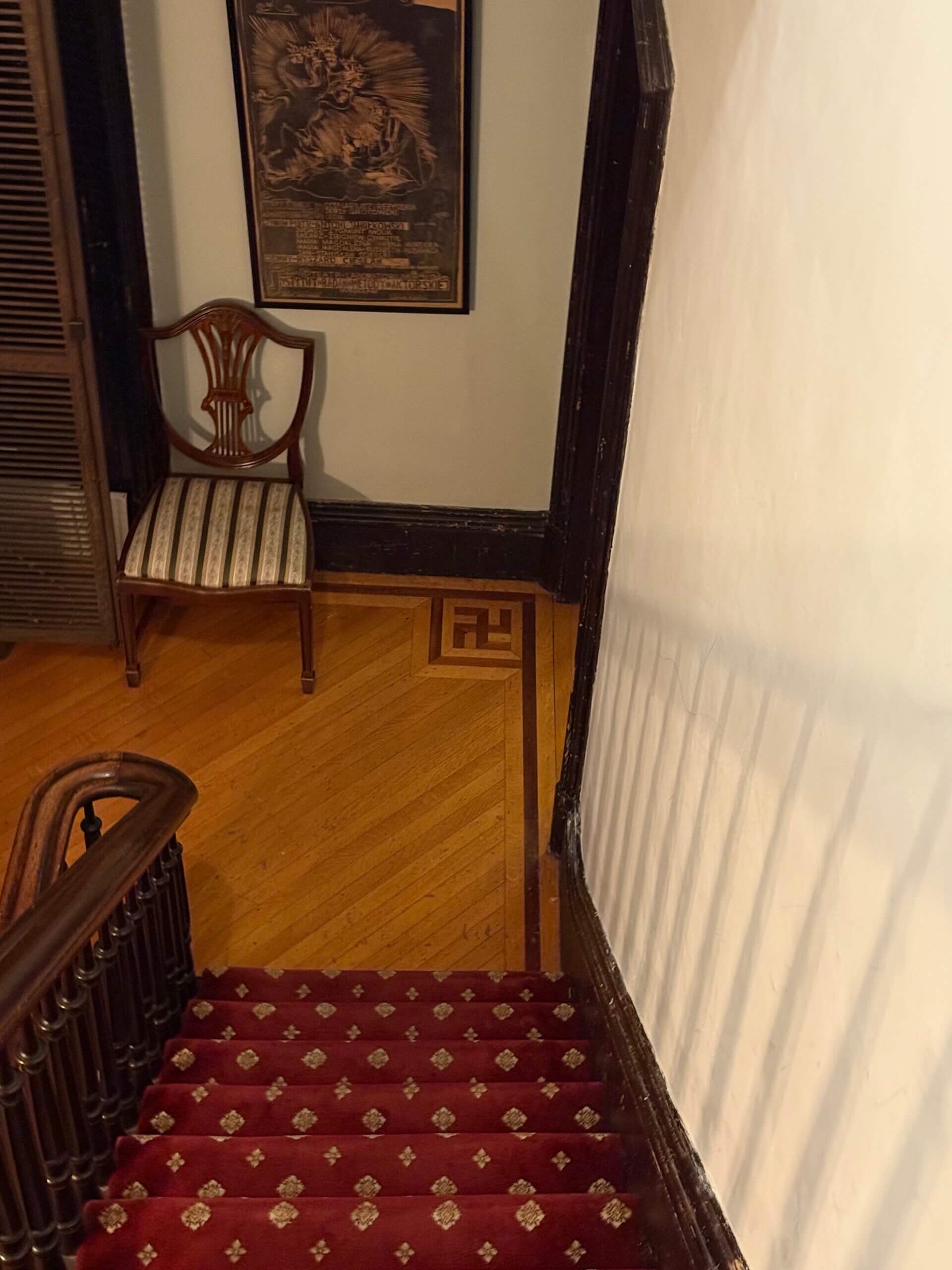
A few weekends ago I went upstate for a wedding, and briefly lived like a Victorian gentleman with a problematic taste in interior design.
Staying in a historic mansion (h/t Airbnb) in Newburgh, New York, I felt transported into a game of Clue, minus the murder. Was it me in the study with a sandwich? The parlor had a marble bust redolent of antiquity. From my top floor room there were panoramic views of the Hudson hills bursting with fall foliage. And then there was, at the corner of the landing … well, as I told my girlfriend, it’s more of a visual.
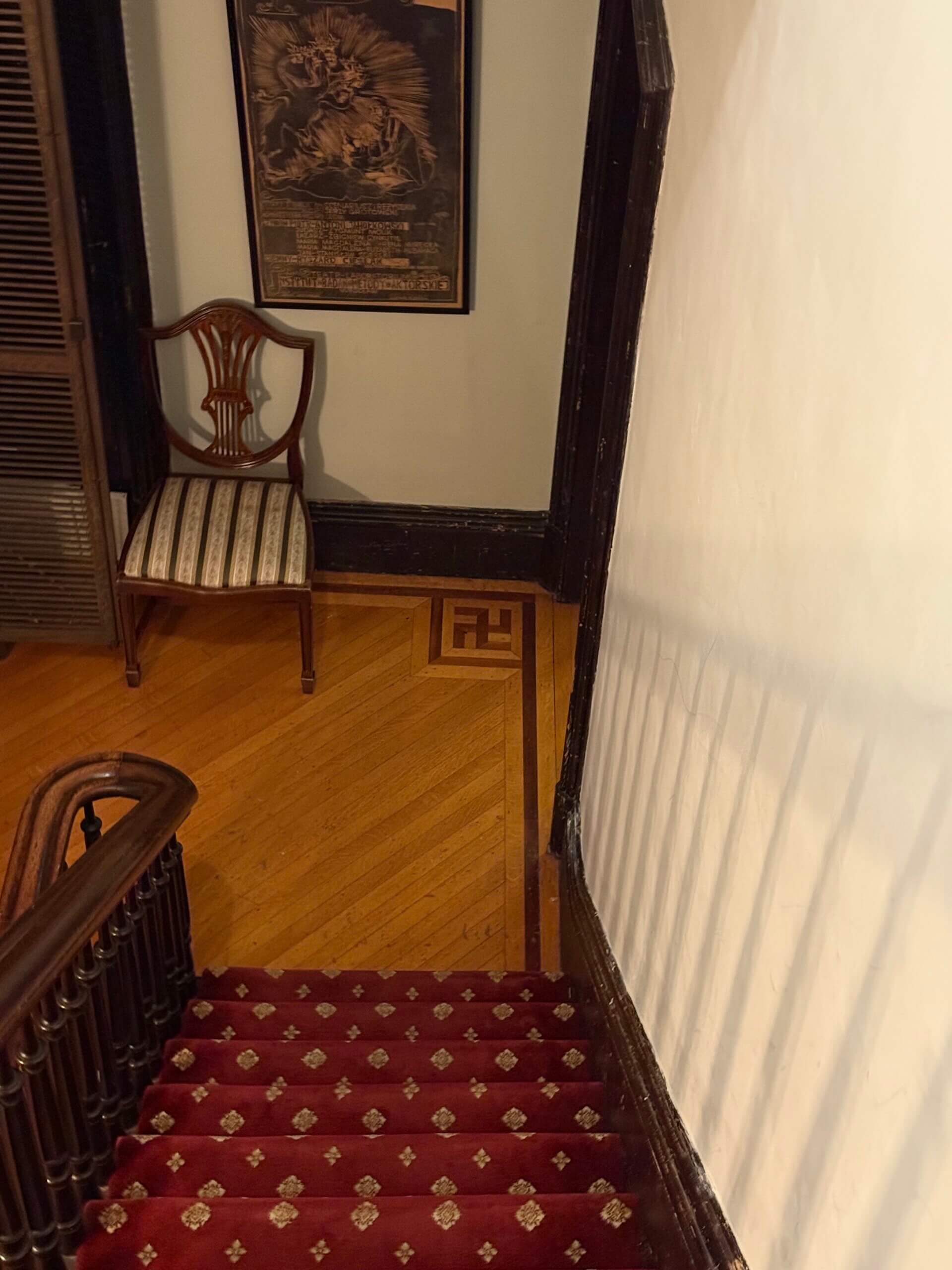
“Please do not be alarmed, but there are sauvastikas (more commonly known as swastikas) inlaid in the corners of the floors dating back to 1866, before Hitler was born,” the extensive house instructions said.
I wasn’t alarmed, more amused. (For context, the guests were almost entirely Asian with a couple of Ashkenazi Jews — and a miniature poodle.)
Of course I knew the Eastern origins of the motif. And I noted, as did our hosts, that these swastikas faced the opposite direction of the hooked cross favored by the Third Reich. The owners were right to say in their literature that the symbol “was stolen.”
Nazis really do ruin everything.
The architect, Frederick Withers, could only really be faulted for orientalism, which at the time wasn’t a dirty word. In any case, this was a landmark building registered with the historical society, and as such the swastikas couldn’t be altered. (“On a positive note,” our hosts added, “the original Tiffany stained glass window is well preserved up in the dining room.”)
At the wedding, I made the possible faux pas of mentioning the floors to friends of ours, one of whom grew up in India. It had just been Diwali, and he said kids draw swastikas everywhere during the festival.
“You’re taking it back,” I joked.
On the contrary, he said, they never really let it get taken away. Indians still use the swastika to signify peace and prosperity — its original meaning.
Maybe there’s a lesson there. Not really about ancient Indian symbols, but about what we feel comfortable letting Nazis get away with.
It’s long been a pet peeve of mine that so much of Jewish culture is boiled down to a period of about 12 years in a history that stretches back millennia. That public figures caught saying something antisemitic are immediately dispatched to the nearest Holocaust museum, rather than a Shabbat dinner or a museum of Jewish art.
When people online get defensive about their views on the Jews, they often mention how moved they were by Anne Frank’s diary, as if that was the answer key for understanding our peoplehood, and not just assigned reading. (In most schools in the U.S., the only time students hear anything about Jews is in a unit on the Holocaust.)
Members of the tribe are far from immune to this phenomenon. To be an educated, secular Jew, for many, is to have endured a screening of Schindler’s List — or, if you’re more ambitious, the more than 9 hours of Claude Lanzmann’s Shoah. You don’t see the Talmud in every Jewish home (granted, it takes up a lot of shelf space), but you can probably find a copy of William Shirer’s Rise and Fall of the Third Reich.
Jewish identity has been shaped by our persecution — and remembrance is an important Jewish imperative — but as I’m far from the first to point out, when we take history and memory culture to extremes, we end up ceding our own narrative to those who wanted to erase us.
As scholar Miriam Udel put it in her recent book, “The Holocaust is, in a profound sense, not a Jewish story.” This stopped me when I first read it, but the more I considered it, the more I saw her point. The way the Shoah is typically related, it’s not a story where Jews have a great deal of agency. Jews weren’t passive. Tales of resistance abound — and should be emphasized — but it’s still primarily a story in which something was done to the Jews, and for reasons the Jews had no real control over.
Indians don’t let Nazis have a monopoly on the swastika — why should Jews allow them to define Jewishness?
I am not advocating for the return of parquet-inlaid swastikas in Western homes, whatever their direction. I’m not even for a revival of the Hitler mustache that Michael Jordan once attempted to resuscitate in a Hanes undershirt commercial. But I do think there’s a wisdom in not permitting our enemies to distort our much older tradition.
In Yiddish, we say “mir veln zey iberlebn,” we will outlive them — them being Nazis, antisemites and the various Hamans that rise up in every generation. While today that seems aspirational, we must remember we were here first, and there’s far more to Jewish life than death.
The post So, there was a swastika at my Airbnb appeared first on The Forward.


